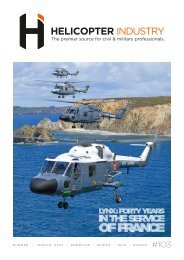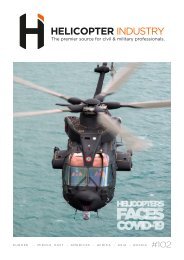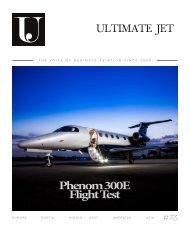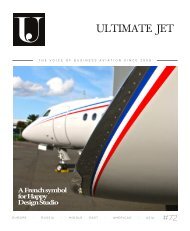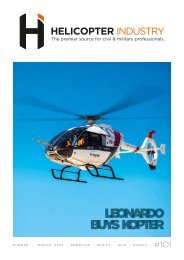Magazine Ultimate Jet #74
You also want an ePaper? Increase the reach of your titles
YUMPU automatically turns print PDFs into web optimized ePapers that Google loves.
OPERATOR I 42<br />
Dedicated to training<br />
Nothing distinguishes a Falcon 10 Mer from a civilian version except<br />
the gray and white lining that it has worn since it entered service in<br />
1975. This is because the Navy’s version is in fact totally similar to<br />
that of civilian operators, even from the point of view of its avionics.<br />
Its utilization within the naval forces, and more particularly within the<br />
Escadrille 57S, did not require any specific modifications. Indeed, the<br />
main mission of the aircraft is still the training of on-board fighter<br />
pilots on instrument use and French military procedures. As Frégate<br />
Captain François Daylaud, commanding officer of Escadrille 57S,<br />
points out: «The main purpose of the 57S is to train students who are<br />
returning from training in the United States, on flight procedures in the<br />
French territory. ». Following their selection at Lanvéoc, the fighter<br />
pilot students will follow a joint training with American pilots for two<br />
years at the Meridian base in Mississippi, which has been the process<br />
since 2006. While this curriculum, called «full US», allows students<br />
to familiarize themselves with all American military techniques<br />
and procedures, and more broadly, those of NATO, disregarding the<br />
procedures that prevail in French territory. «Our students are re-trained<br />
on flying over land and sea with minima, which is totally different from<br />
that of the United States. The French regulatory framework is indeed<br />
very specific,» emphasizes François Daylaud. In fact, when the first<br />
«macaron» military pilots returned after 12 to 18 months in the US,<br />
the passage through the 57S was an required step, as a young pilot<br />
recently returning from Meridian pointed out: «The rules are not the<br />
same, and the French airspace is extremely dense. Switching to the 57S<br />
as soon as we returned from a two-week period allows us to rethink<br />
and learn about the regulations, which are totally different from those<br />
in the USA. ». The easy handling and performance of the Dassault<br />
twin-engine aircraft was perfectly adapted to this environment. Its<br />
speed and range of 3,500 km (1,922 nm) greatly facilitates the work<br />
of the instructors, who have a wide range of capabilities, so that they<br />
can truly test the capacity of the students’ knowledge, in addition<br />
to their ability to evolve in different French terrains. Beyond that,<br />
the business jet can also be used for low altitude adaptation flights<br />
at 500ft above the ground, which is a procedure that is generally<br />
forbidden in the USA. «On returning from the United States, the refresher<br />
course takes four weeks and includes six flights dedicated to instrument<br />
training, five flights over land, and between four and six flights over the<br />
sea, in order to brush up on low altitude learning and validate reflexes,»<br />
said the squadron commander. In parallel with training on French<br />
territory, the 57S conducts daily flights abroad to maintain its level<br />
of competence. It conducts training on and from Dublin airport, less<br />
than 45 minutes away from Landivisiau. «We try to carry out, as many<br />
as possible, regular training flights at all the major European airfields, not<br />
only for pilot training but also in the event that we have to convoy a high<br />
authority. These outings enable us to deal more regularly with sometimes<br />
very complex civil procedures, and also maintain the operational level of<br />
our crews,» comments Daylaud.




